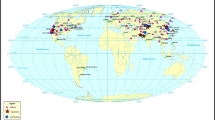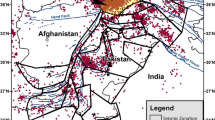Abstract
Classification methods with Machine Learning have been used in various fields, including volcanology. This method makes it possible to automatically perform data processing and classification on large scale data in a short time. Seismic time series data from volcanic earthquakes of Mt. Merapi are classified into five types of earthquakes, i.e.: Volcanic Type A (VTA), Volcanic Type B (VTB), Multiphase (MP), Low-frequency (LF) and Rockfall (RF), with a total sample data of 266 earthquakes, could be classified automatically using machine learning. The features of the signal are taken from the dominant frequency value, the spectral pattern that is formed, and the amplitude value to differentiate the earthquake dataset into each class. Classification is done using the XGBoost algorithm. Tests were carried out using various data test–train percentage to get the best result. Based on the XGBoost function test, which the best value obtained with an accuracy of testing the data is 76.67% using the 70%:30% train–test scenario. The results of this accuracy value are greater when compared to the accuracy value of previous studies with the SVM method which is 74.4% accuracy. This research also has better results in spectral analysis with the results of spectral comparison plots that appear to show more significant differences.







Similar content being viewed by others
References
Abdurachman (2006) "Klasifikasi gunung api aktif Indonesia, studi kasus dari beberapa letusan gunung api dalam sejarah", Indonesian Journal on Geoscience, 1(4), pp.209–227. Available at: http://ijog.bgl.esdm.go.id/index.php/IJOG/article/view/23 (Accessed: 30 December 2021).
Budi-Santoso A, Lesage P, Dwiyono S, Sumarti S, Subandriyo S, Jousset P, Metaxian J (2013) Analysis of the seismic activity associated with the 2010 eruption of Merapi Volcano, Java. J Volcanol Geoth Res 261:153–170
Camus G et al (2000) Merapi (central java, Indonesia): An outline of the structural and magmatological evolution, with a special emphasis to the major pyroclastic events. J Volcanol Geotherm Res 100(1–4):139–163
Chai T, Draxler RR (2014) Root mean square error (RMSE) or mean absolute error (MAE)? Arguments against avoiding RMSE in the literature. Geosci Model Dev 7:1247–1250
Chen T, Guestrin C (2016) XGBoost: a scalable tree boosting system. In: Proceedings of the 22nd ACM SIGKDD international conference on knowledge discovery and data mining [Preprint]. https://doi.org/10.1145/2939672.2939785
Friedman JH (2001) Greedy function approximation: a gradient boosting machine. Ann Statist 29(5):1189–1232
Hashmi S, Halawani MO, AmirAhmad MB (2015) Model trees and sequential minimal optimization based support vector machine models for estimating minimum surface roughness value. Appl Math Model 39(3):1119–1136
Kortström J, Uski M, Tiira T (2016) Automatic classification of seismik events within a regional seismograph network. Comput Geosci 87:22–30
Lahr J, Chouet B, Stephens C, Power J, Page R (1994) Earthquake classification, location, and error analysis in a volcanic environment: implications for the magmatic system of the 1989–1990 eruptions at redoubt volcano, Alaska. J Volcanol Geoth Res 62(1–4):137–151
Malfante M, Dalla Mura M, Metaxian J, Mars J, Macedo O, Inza A (2018) Machine learning for volcano-seismik signals: challenges and perspectives. IEEE Signal Process Mag 35(2):20–30
Nandaka I, Sulistiyani Suharna Y, Putra R (2019) Overview of merapi volcanic activities from monitoring data 1992–2011 Periods. J Disaster Res 14(1):18–26
Ohrnberger M (2001) Continuous automatic classification of seismic signals of volcanic origin at Mt Merapi. Java, Indonesia
Ratdomopurbo A, Poupinet G (2000) An overview of the seismikity of Merapi volcano (Java, Indonesia), 1983–1994. J Volcanol Geoth Res 100(1–4):193–214
Saroji S et al (2021) The implementation of machine learning in lithofacies classification using multi well logs data. Aceh Int J Sci Technol 10(1):9–17
Shimozuru D (1968) Discussion on the energy partition of volcanic eruption. Bulletin Volcanologique 32(2):383–394
Suresh GV, Sreenivasa EV (2022) Uncertain data analysis with regularized XGBoost. Webology 19(1):3722–3740
Unpingco J (2019) Python for Probability, Statistics, and Machine Learning. Springer, Switzerland
Voight B, Young K, Hidayat D, Subandrio Purbawinata M, Ratdomopurbo A, Panut S, Sayudi D, LaHusen R, Marso J, Murray T, Dejean M, Iguchi M, Ishihara K (2000) Deformation and seismic precursors to dome-collapse and fountain-collapse nuées ardentes at Merapi Volcano, Java, Indonesia, 1994–1998. J Volcanol Geotherm Res 100(1–4):261–287
Wrona T, Magee C, Jackson C, Huuse M, Taylor K (2017) Kinematics of polygonal fault systems: observations from the Northern North Sea. Front Earth Sci. https://doi.org/10.3389/feart.2017.00101
Yanghong T, Yigang H (2008) A novel method for fault diagnosis of analog circuits based on WP and GPNN. Int J Electron 95(5):431–439
Young S, Sparks R, Aspinall W, Lynch L, Miller A, Robertson R, Shepherd J (1998) Overview of the eruption of Soufriere Hills Volcano, Montserrat, 18 July 1995 to December 1997. Geophys Res Lett 25(18):3389–3392
Zheng Z, Pan S, Luo H, Guo Z (2020) Porosity prediction based on GS+ GA-XGBoost. In 2020 IEEE Intl Conf on Parallel & Distributed Processing with Applications, Big Data & Cloud Computing, Sustainable Computing & Communications, Social Computing & Networking (ISPA/BDCloud/SocialCom/SustainCom) (pp. 1014-1020). IEEE.
Funding
Universitas Gadjah Mada.
Author information
Authors and Affiliations
Corresponding author
Ethics declarations
Conflict of interest
The authors declare that they have no the conflict of interest.
Additional information
Edited by Dr. Salvatore Gambino (ASSOCIATE EDITOR) / Prof. Ramón Zúñiga (CO-EDITOR-IN-CHIEF).
Rights and permissions
Springer Nature or its licensor (e.g. a society or other partner) holds exclusive rights to this article under a publishing agreement with the author(s) or other rightsholder(s); author self-archiving of the accepted manuscript version of this article is solely governed by the terms of such publishing agreement and applicable law.
About this article
Cite this article
Sidik, I., Saroji, S. & Sulistyani, S. Implementation of machine learning for volcanic earthquake pattern classification using XGBoost algorithm. Acta Geophys. 72, 1575–1585 (2024). https://doi.org/10.1007/s11600-023-01154-w
Received:
Accepted:
Published:
Issue Date:
DOI: https://doi.org/10.1007/s11600-023-01154-w




